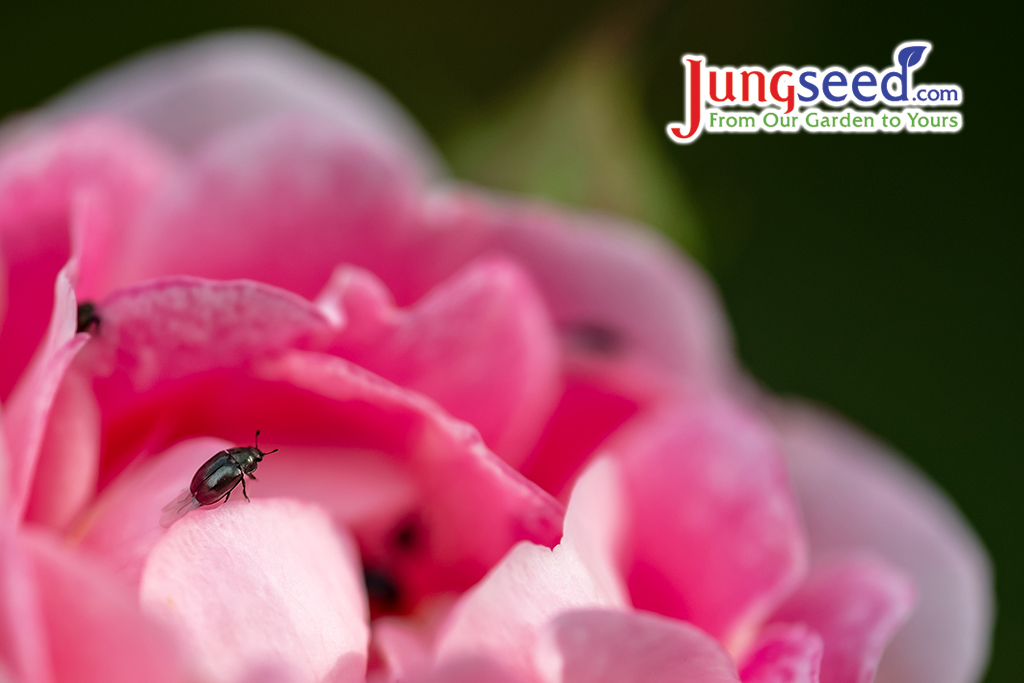
New and experienced rose growers know, there are a number of insect pests that are attracted to roses. These pests may affect flower development, the foliage or overall quality of a rose bush. These pests are not likely to destroy an entire plant, but they can severely damage or stunt parts of the plant. Any cosmetic damage done to your rose bush is unwanted!
Regular inspection of your roses is important in order to minimize any damaging effects of insects. You may find evidence of leaf chewing, damage from piercing and sucking insects or other suspicious damage to a plant. As soon as you see something out of the ordinary, it will be important to properly identify the culprit.
There are several different categories of insect defoliators; they may be leaf feeders, piercing and sucking feeders, bud and shoot feeders, gall makers, and stem borers that you need to be aware of in making your diagnosis.
Defoliators/Leaf Feeders
False Japanese Beetle
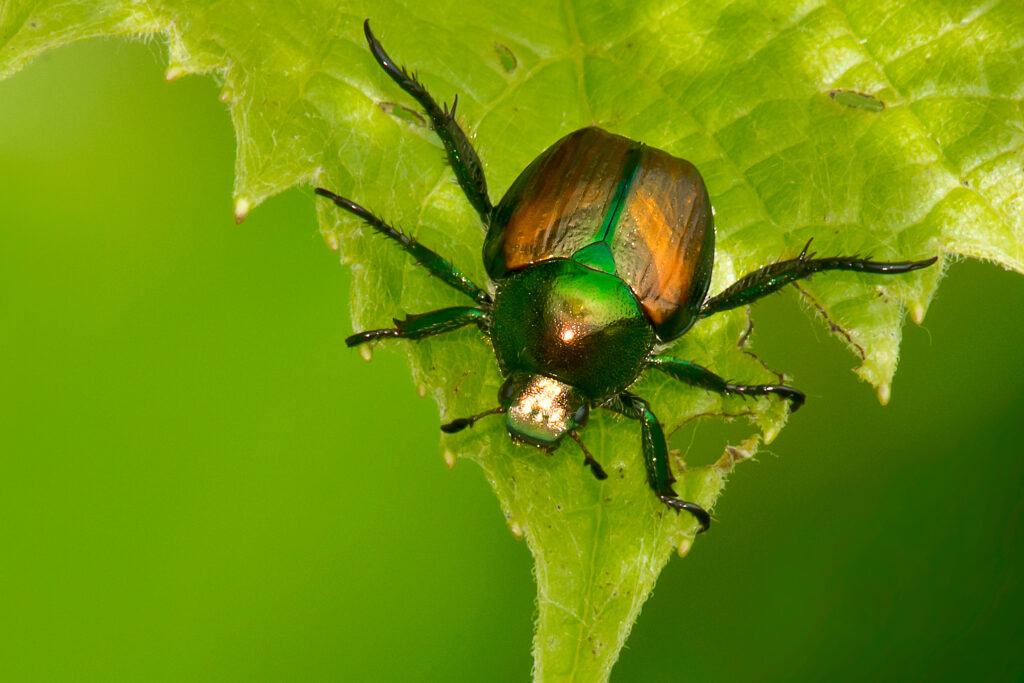
The false Japanese beetle is a scarab beetle that resembles the Japanese Beetle and is native to Minnesota but is less of a problem species. The adult beetles are about 7/16 inch long and are a dark tan to brown color. Some may have a slight metallic green color on the front third of the body, though not as bright as the Japanese beetle. There are no white tufts along the dorsal abdomen edges as is found on the Japanese beetle. Control of larval grubs in the lawn is the best long-term control option.
SCOUTING: This insect has not been studied extensively. Larvae feed on plant roots, but a species list is not well known. Adults are found on wild and cultivated roses. When numbers of adults are large, the beetles damage roses by feeding on buds and flowers.
CONTROL: Handpick if the infestation is light. The insecticides carbaryl (Sevin), acephate (Orthene), diazinon, and chlorpyrifos (Dursban) control these beetles. However, these beetles are also quite mobile and new beetles may replace those killed by insecticides. Avoid spraying flowers so as to not to kill the bees.
Fuller Rose Beetle
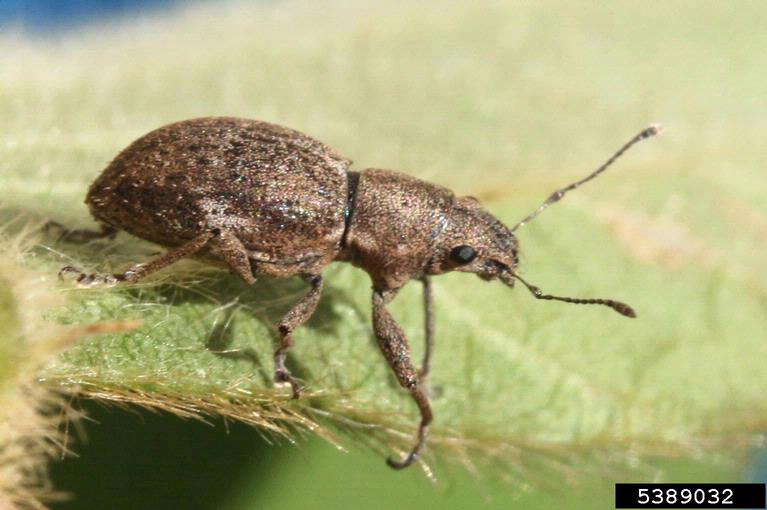
The fuller rose beetle is a weevil with a short snout. The adult weevil is brown with black mottled markings and about 5/8 inch long. You may not see the beetle, only the damage they have done during the night.
SCOUTING: Both larvae and adults are pests. Larvae feed on roots while the adults chew foliage and flowers. Adults generally feed during the night and are considered to be more damaging.
CONTROL: Control is similar to other beetle defoliators. Hand-picking at night is an option with low populations. The insecticides carbaryl (Sevin Dust), Spinosad (Capt’n Jack’s), Permethrin (Eight®), and Pyrethrins to help control these beetles. However, this type of beetle is nocturnal and very mobile so insecticide use may have limited effectiveness. Avoid spraying flowers so as to not kill bees.
Japanese Beetle
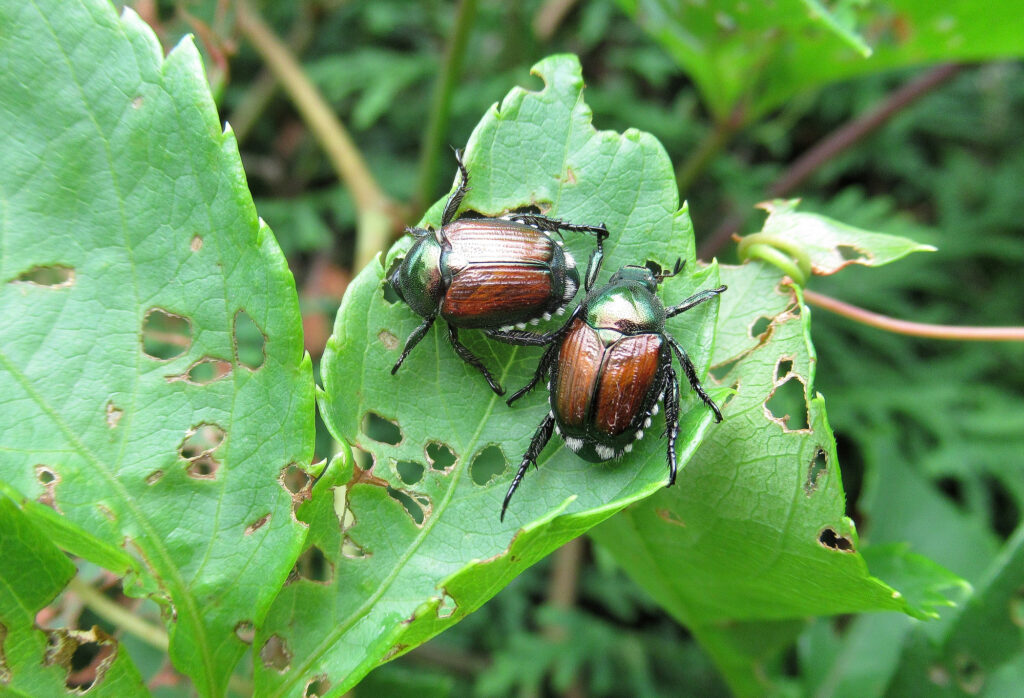
The Japanese beetle is a scarab beetle and an exotic insect that became established in the east and has taken hold across the United States. Japanese beetles are approximately 7/16 inches long. The front of the beetle is dark metallic green and the wing covers are dark tan. There are five small, white patches of short hairs along each side of the dorsal abdomen on the beetle. These patches are a key characteristic for identification. If it doesn’t have these white hair tufts, it isn’t a Japanese beetle.
SCOUTING: One of the favored foods of adult Japanese beetles is rose foliage and flowers, although adults feed on many plant species. Larvae feed on the roots of grasses. Inspect your plants for skeletonized leaves and the presence of the adult beetles. As soon as one beetle starts feeding, they emit a wafting pheromone that alerts other adult beetles that they found a good food source and to come to join them. This is why so many beetles can quickly overwhelm one plant. That pheromone is what Japanese beetle traps are laced with to attract the beetles.
FOR CONTROL: Handpick if the infestation is light. The insecticides with Permethrin, like Eight® Liquid Concentrate, Pyrethrins, and also Captain Jack’s Deadbug Brew® are all good and low-impact pesticides for control. However, these beetles are strong fliers, quite mobile and new beetles may replace those killed by insecticides. Avoid spraying flowers so as to not kill bees.
Leafcutting Bees
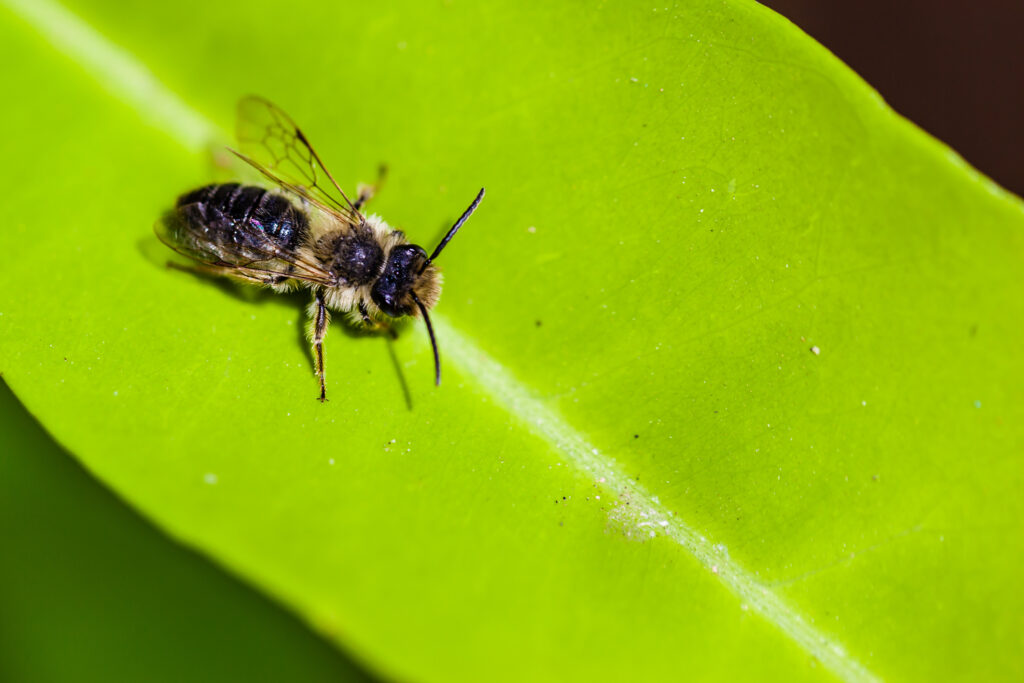
Leafcutting bees are similar in size to honeybees but are blackish in color. Leafcutter bees are solitary bees that are also pollinators.
SCOUTING: Leafcutting bees cut out sections of rose and other plant leaves to line their nests. The damage of leafcutting bees is quite distinctive. The holes are circular in shape with a clean, smooth edge, always on the edge of a leaf. The female leafcutter bee prefers the softer, new leaf growth.
CONTROL: Damage from leafcutter bees is purely cosmetic and will not affect the plant whatsoever. No control measure is warranted because they are beneficial pollinators.
Rose Chafers
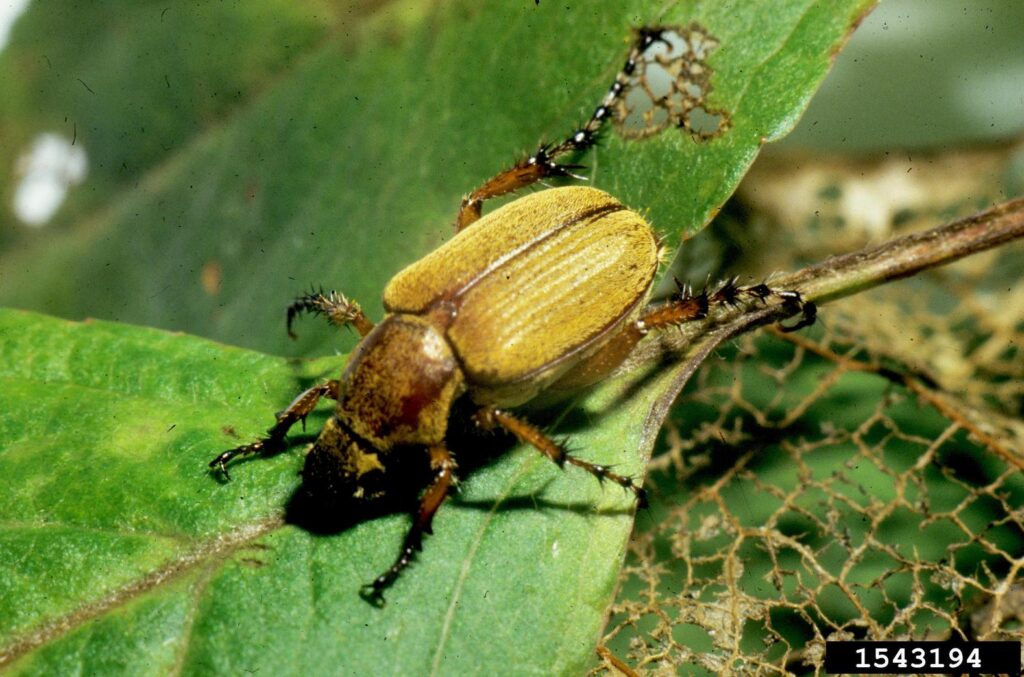
Rose chafers are scarab beetles approximately 3/8 inch long, slender, light tan, and lacking the white hair tufts of Japanese beetles.
SCOUTING: Rose chafers are generally found in areas with sandy soil. Adults feed on rose flowers and foliage. The larvae feed on the roots of grasses, alfalfa, or clover sod. Inspect your plants for skeletonized leaves and adult beetles.
CONTROL: While rose chafers can be numerous, handpick if the infestation is light. The insecticides carbaryl (Sevin), Spinosad (Capt’n Jack’s), and Permethrin (Eight®) can help control these beetles. These beetles are also quite mobile and strong fliers so they are difficult to control only by insecticides. Avoid spraying the flowers so as not to kill the bees.
Sawflies
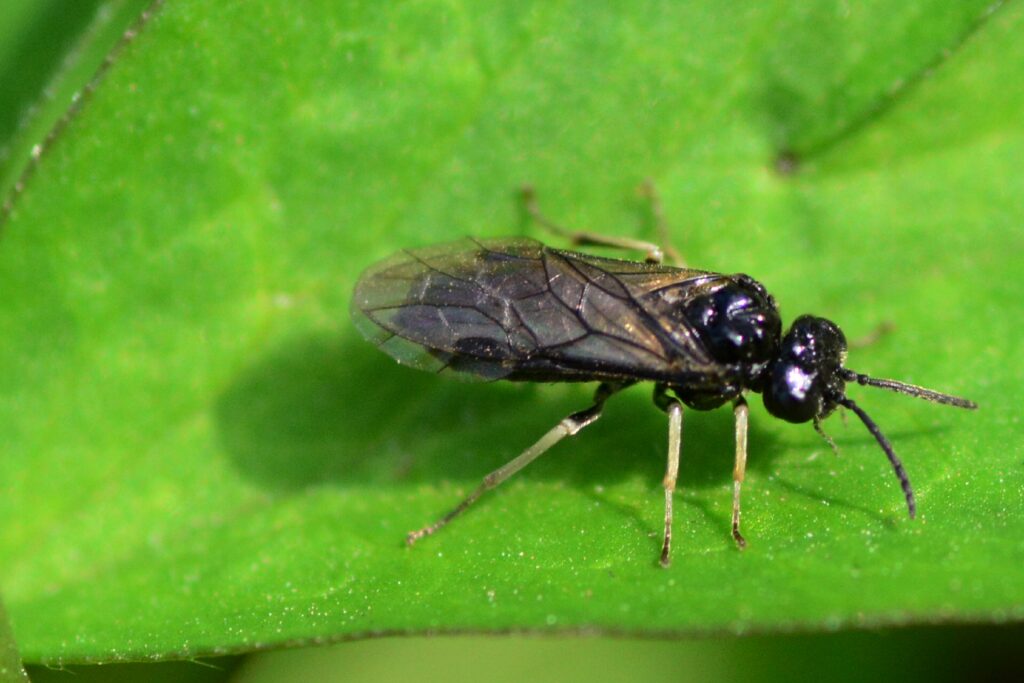
Are small, dark, non-stinging wasps. Sawfly larvae feed on leaf tissue between the leaf veins of the leaves. These larvae are green with an orange-red head and look much like butterfly or moth caterpillars, with the distinct difference that sawfly larvae are slimy looking. All sawfly larvae species are about 3/4″ in length.
SCOUTING: As mentioned, rose sawflies produce damage called skeletonization, by chewing away a layer of the leaf except for the veins. The thin layer remaining turns to clear brown and the uneaten veins appear like a skeleton. However, older larvae of the bristly rose slug and curled rose sawfly chew holes rather than skeletonizing the leaves.
Sawfly larvae emerge and begin feeding in early spring. Start monitoring as temperatures warm. Rose slugs feed through June and are not seen again until the next spring. The curled rose sawfly also has one generation per year. The bristly rose slug has several generations throughout the summer. Sawflies often feed on the undersides of leaves, so inspect all leaf surfaces.
CONTROL: Sawflies are best controlled when young. Several options exist for control. A physical tactic is to simply pick them off by hand. Dislodging them with a stick or a stream of water also works. They are not good climbers, so once on the ground birds and other beneficial insects will find them to be a tasty treat. If using water be sure to spray early enough in the day to allow foliage to be dry by sunset so as not to create favorable conditions for fungal development.
Horticultural oil sprays and neem oil are low-toxicity biorational insecticides for the control of young sawfly larvae. Neem is slower acting. Bacillus thuringiensis (Bt) is not effective on larval sawflies. It is a fly, not a moth or butterfly larvae that Bt controls. Insecticidal soaps are an effective, safe pesticide to help control this kind of soft-bodied larvae. Other natural and biological insecticides that work well are, Pyrethrins and Spinosad, which is the active ingredient in Captain Jack’s Deadbug Brew® by Bonide. Always avoid spraying the rose flowers, as many conventional insecticides are highly toxic to bees.
Piercing/Sucking Feeders
Aphids
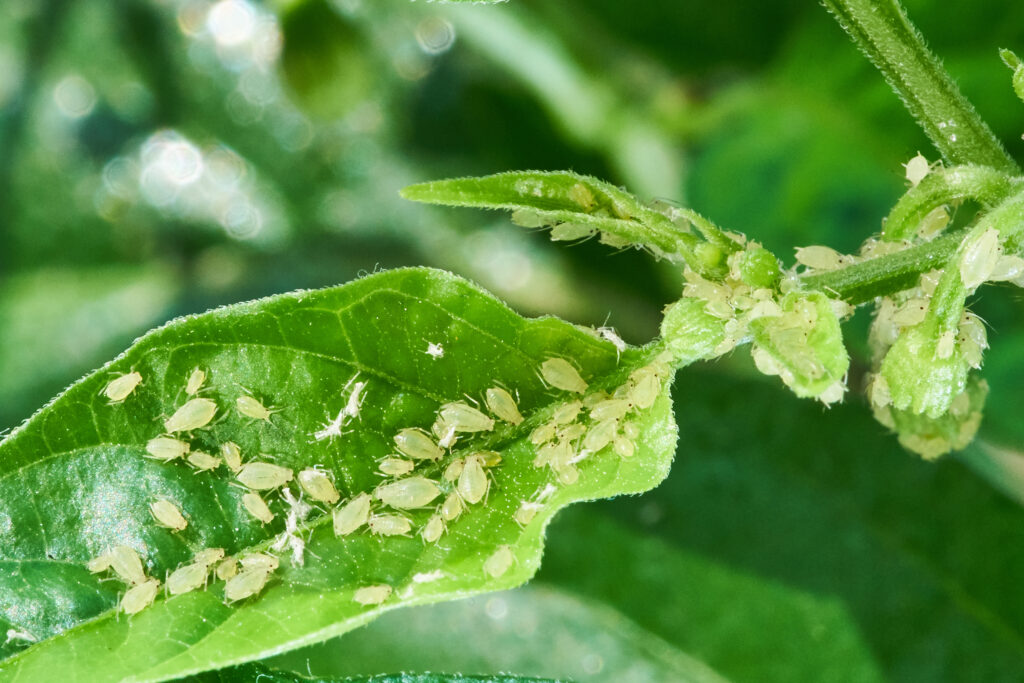
Are small, inconspicuous insects that feed in groups near the tips of new shoots and flower buds. Those found on roses are generally green or pinkish and up to 1/8 inch long.
SCOUTING: Aphids feed by sucking plant juices, causing distortion of young leaves and stunting new growth. Flowers may also be affected when aphids feed on the buds. Watch for honeydew, a clear, shiny, sticky waste product that collects on to the leaves below the aphids and attracts ants. A black fungus called sooty mold also grows on the honeydew.
Look for beneficial insects where you see aphids. Lacewing and ladybird beetle larvae and adults are among the naturally occurring predators of aphids. Tiny parasitic wasps also control aphids by laying their eggs inside the aphids. The wasp larva feeds inside the aphid, killing it and leaving mummies-dark, swollen, motionless aphids with a hole in them.
CONTROL: While they have many natural predators and parasites, aphid populations can increase rapidly. Biological insecticides such as insecticidal soap are very effective on aphids. Since insecticidal soaps work well on aphids and have low toxicity, they are suggested over conventional insecticides. Insecticidal soaps must contact the aphids directly. Like other insect pests control can be achieved by using Neem oil, which is a suffocant, and Spinosad (Capt’n Jack’s) and Pyrethrins made from Chrysanthemums. A long-term strategy is to add and enhance beneficial insects in your yard, such as ladybird beetles (Ladybugs) or lacewings. Aphids are a natural and desirable food source for these beneficial predators.
Twospotted Spider Mites
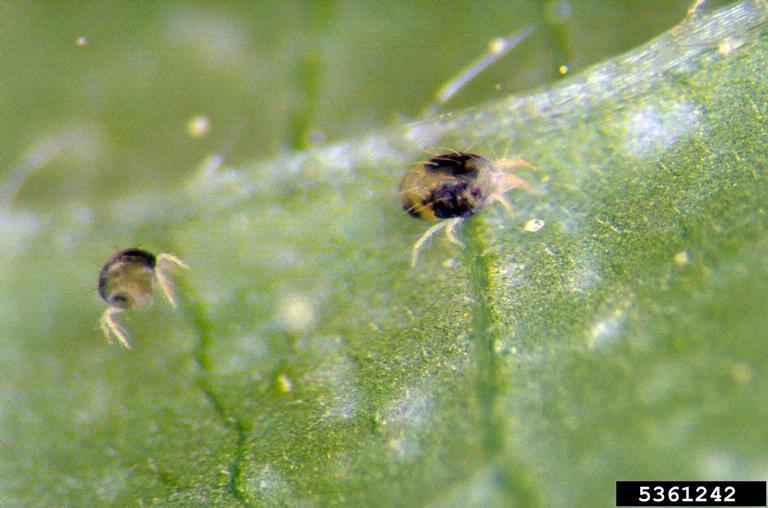
Mites are not insects but are closely related to both insects and spiders. This mite is a yellowish-green with a black spot on each side of the body. Mites are tiny and usually difficult to see without a hand lens.
SCOUTING: Mites feed by sucking plant juices out of individual cells from a wide variety of ornamental plants including roses. This causes small Yellowish stippling (like spray paint droplets) on the foliage of host plants. Also, look for very fine webbing on leaves and stems. As a result Of heavy mite populations, leaves may turn yellow and drop from the plant. You can also check for mites by shaking branches over a white sheet of paper. The mites show up as tiny moving greenish specks.
CONTROL: Insecticidal soap and horticultural oils are safe biologicals for mites, although the subsequent application is necessary. If the population is large conventional pesticide use may be warranted. Mites are not insects. Consequently, pesticides called miticides are used for control. Dicofol (Kelthane) is an available miticide. Conventional insecticides with miticidal properties are appropriate. Read the product label to see if spider mites are listed. Focus mite control on the undersides of leaves and treat the entire plant. For effective control, multiple miticidal products should be used in an alternating, bilateral spray sequence.
Bud/Shoot Feeders
Rose Curculio
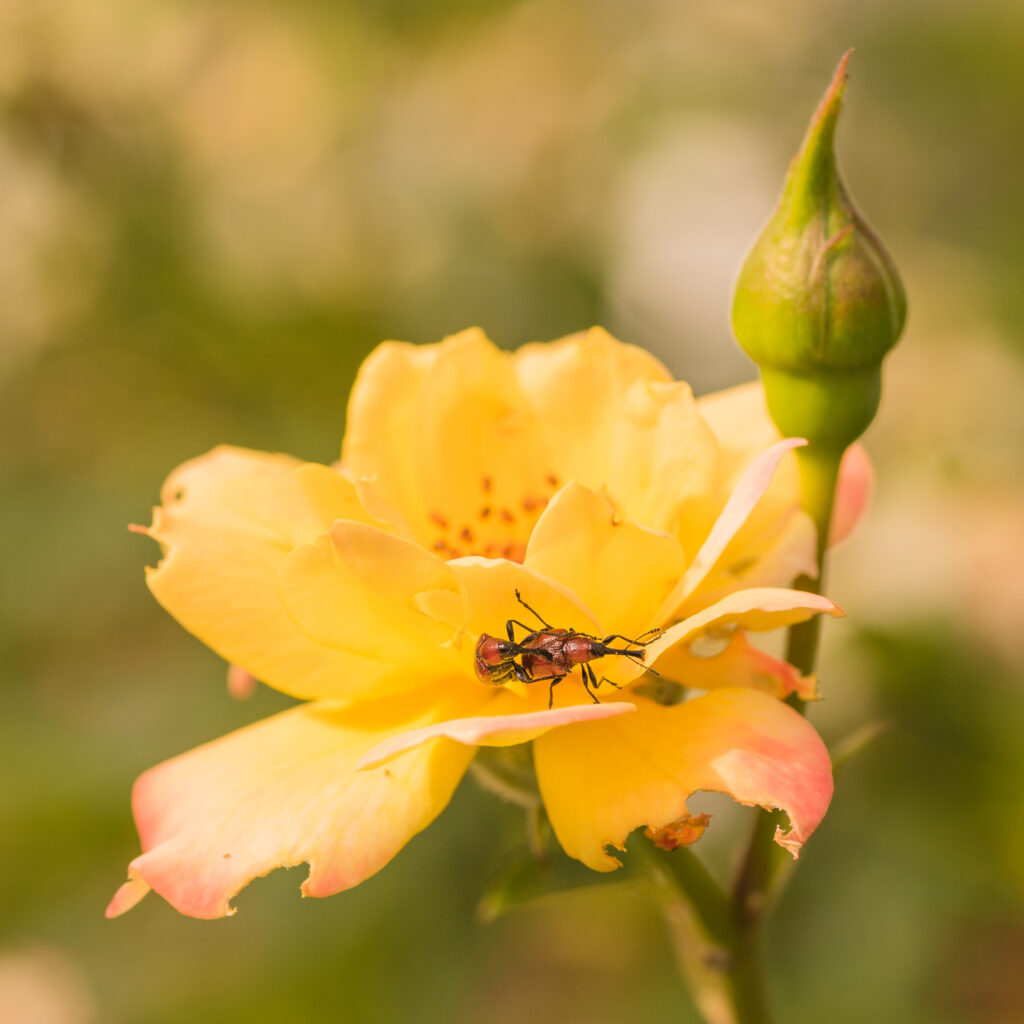
The adult rose curculio weevil is reddish in color with a long snout. The head, snout, legs, and underside are black. Adults are approximately 3/16 inch in length.
SCOUTING: These weevils feed on all types of roses, especially shrub roses. Adults feed on rose buds and on shoot tips, resulting in damaged petals and dead shoot tips. Feeding on the stem below the bud can cause it to bend over. Larvae feed in rose flower buds. The legless larvae are similar in color to rose midge larvae, are up to 1/4 inch, and are more robust. There is a single generation each year with adults appearing in June.
CONTROL: Handpick adults if few in number. When bothered, adults fall quickly and illusively from the plant to the ground. Therefore, gently shake canes over a bucket or try to collect fallen adults. Prune out and remove finished flowers to remove larvae, which can help reduce future problems. Deterrent sprays of essential botanical oils like lavender, garlic, and peppermint can sometimes be effective for management, otherwise, insecticides you might employ would include carbaryl (Sevin), Diatomaceous Earth, or Permethrin (Eight®), Spinosad (Capt’n Jack’s Deadbug Brew).
Rose Midge
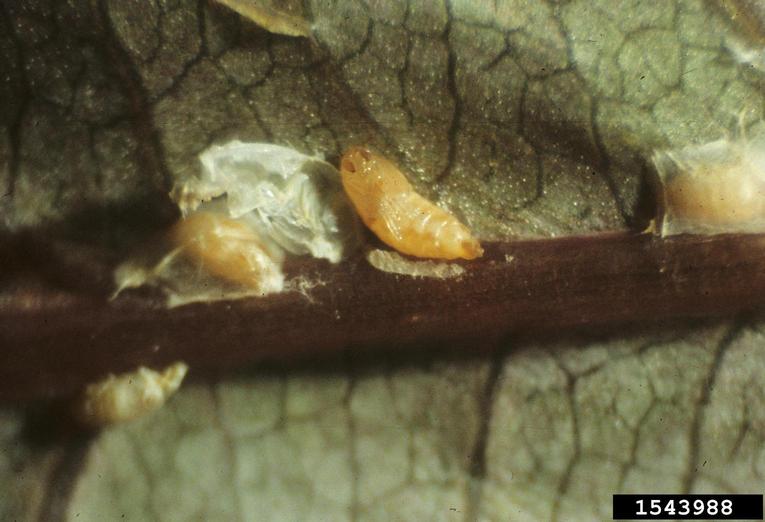
The rose midge is a tiny fly that lays its eggs in the buds and shoots of roses. The legless fly larvae are small whitish maggots about 1/16 inch in length.
SCOUTING: Feeding by the larvae causes bent, misshapen, or blasted buds and withering stem tips. Flower buds and growing shoots turn brown and finally black, with a magnifying lens, look for the small whitish larvae Between the petals and sepals at the base of the flower bud to verify the presence of midge larvae.
CONTROL: Prune out these infested buds to remove the larvae, reducing to the number of midges available to reinfest the plants. Midge damage is often noticed after July. Chemical control is needed for persistent problems systemic insecticides may be the best control choice. Acephate (Orthene) and dimethoate (Cygon-2E) are systemic chemical-type products. Prevention can be a very effective control method. In the fall, remove existing mulch from around the plants, to 2 inches where larvae can over-winter and replace with fresh compost or mulch. Discard old mulch.
Gall Makers
Gall Wasps
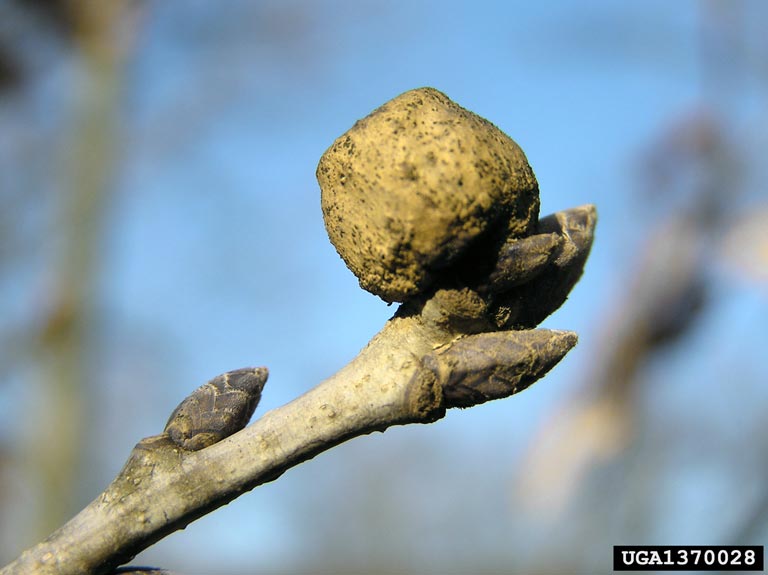
Wasp galls are abnormal plant growths resulting from the activity of the tiny, non-stinging cynipid wasps.
SCOUTING: Rose galls occur on leaves or stems of the rose plant and are specific to the species of gall maker. The mossy rose gall looks like a mossy sphere. The spiny rose gall is round with many pink spines. Insect larvae develop inside the gall. Stem galls can damage plants above the location of the gall, especially if there are many galls on a particular stem. Numerous galls may stress the plant because nutrients otherwise available for plant growth are used to produce galls. Otherwise, galls are purely cosmetic and not a danger to the plant.
CONTROL: Control is best done by pruning out galls before the wasps have matured and emerged from the gall. Since adults emerge from the old galls in spring, prune out the galls after the leaves drop in fall, cutting below the gall and above a bud. For leaf galls, pick up fallen leaves. Removing the galls from the garden may not totally eliminate future problems if adult wasps fly in from nearby areas. Timing for insecticidal treatment of these wasps is difficult and not suggested.
Stem Borers
Carpenter Bees
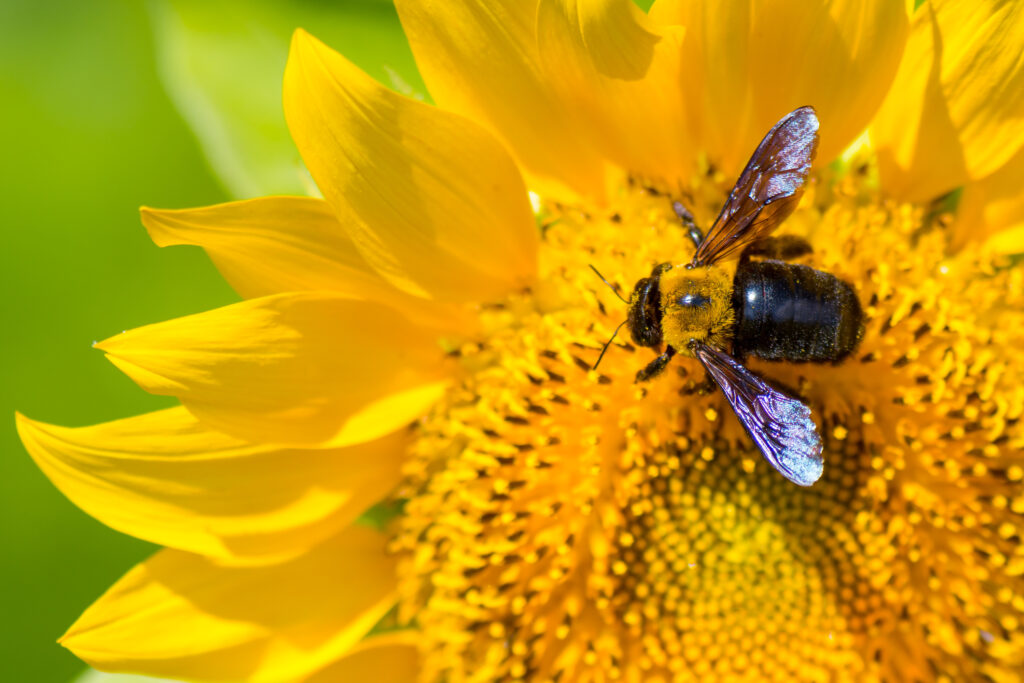
Carpenter bees are small, thin, and metallic blue-black.
SCOUTING: Rose is one of the favored plants of small carpenter bees for nesting. The carpenter bees tunnel in canes to provide a series of rearing cavities for their grublike young. These bees usually tunnel into dead canes. When they tunnel into live parts of the cane those parts die. Damage is generally minimal and rare.
CONTROL: Prune out dead canes to reduce the likelihood of attracting carpenter bees. Chemical control is not recommended.
Rose Stem Girdler
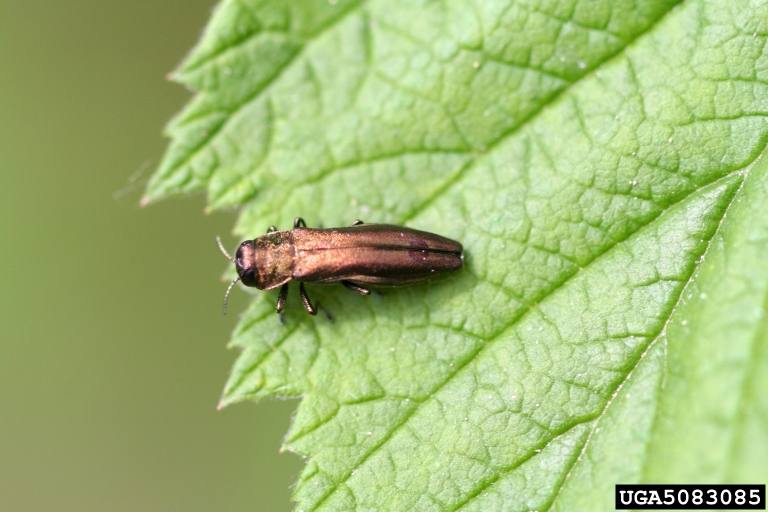
The adult rose stem girdler beetle is about 3/8 inch long, with a flattened body shape. Adults are not likely to be seen. The larva is cream-colored, noticeably segmented, and has a large head. Larvae cannot be seen and feed on the interior canes of the plant.
SCOUTING: The rose stem girdler larva feeds just beneath the bark of rose stems. Its feeding prevents water and nutrient flow in the stem, causing the stem above the feeding area to die. The stem also swells just below the dead area.
CONTROL: When the injury is noticed, prune out the affected stem below the injury and above a bud. Dispose of the pruned canes to remove the insects from the garden. Effective chemical control is difficult and not recommended.
Rose Stem Sawfly
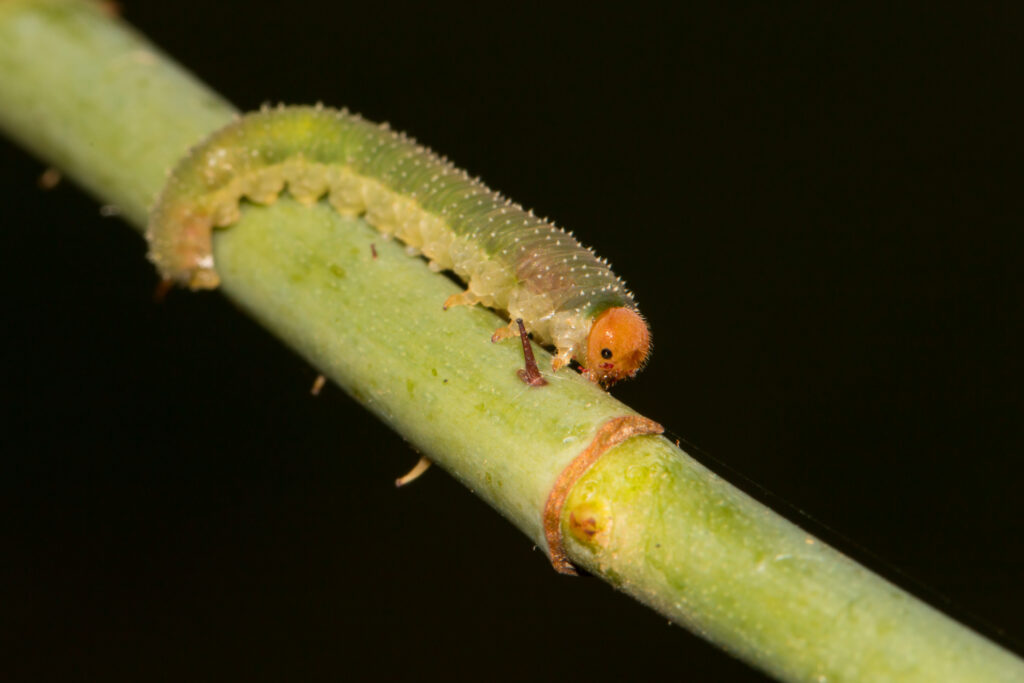
Adult rose stem sawflies are small, dark, non-stinging wasps. The larva is cream colored with a brownish-orange head. It is grub-like and legless. Larvae cannot be seen on the exterior surfaces of the plant.
SCOUTING: This sawfly feeds inside the rose cane rather than on foliage. The larva first feeds just beneath the bark and can girdle the cane from the inside, causing the cane to wilt and die. Older larvae feed in the center of the cane and work downward. One generation is thought to occur per year.
CONTROL: As the larvae move downward in the stem, prune in small increments until you come upon the larva or the pith is solid. Prune above the bud. Dispose of the pruned canes to remove the insects from the garden. Effective chemical control is difficult and not recommended.
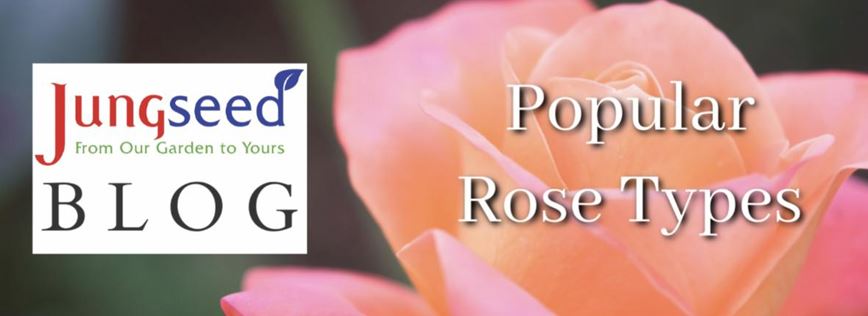
Roses are considered the “Queens” of the flower world, but sometimes nature wants to foil our attempts at producing such beautiful blooms. Being an attentive rose gardener, you can help yourself and your prized rose plants from becoming a major victim of severe damage from many of these unwanted and pesky pests.
Jung Seed offers a wide variety of products to help keep your roses healthy. Sign up for our free catalog or browse our website for all of your gardening favorites. To receive info on new products, exclusive deals, and specials, be sure to sign up for our weekly email. Join our Facebook page, to discuss all things gardening!